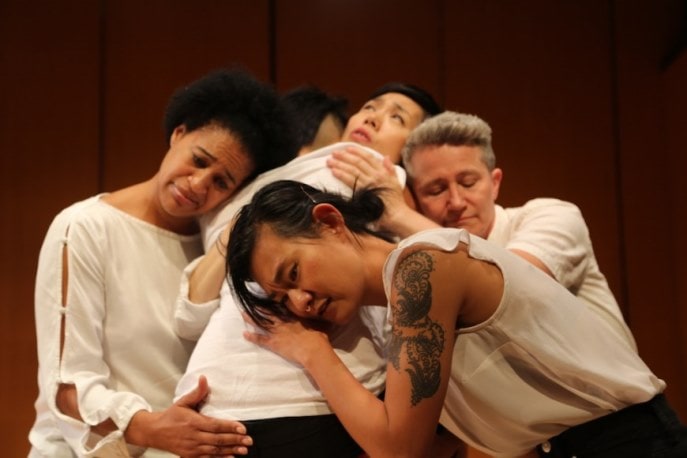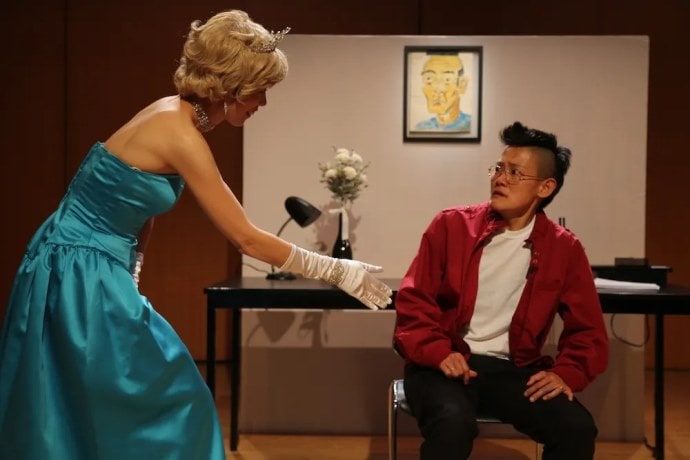The world-premiere production of The Nosebleed, written and directed by Tokyo-born Brooklyn-based theater-maker Aya Ogawa and presented by the Japan Society and the Chocolate Factory Theater, offers an intimate and impactful autobiographical perspective on growing up in the US as a Japanese immigrant, the generation gap between father and child, the playwright’s current experience of parenthood, and the emotional progression from failure to absolution and healing through a series of absurdist, comical, and poignant vignettes and direct-address interactions with the audience.

Ogawa is a master storyteller, as are the four performers – Drae Campbell, Haruna Lee, Saori Tsukada, and Kaili Y. Turner – who play the role of Aya at different times, embodying different psychological and behavioral aspects of the real-life character (as well as shifting to other supporting roles in the self-analyzing narrative). Ogawa assumes the roles of father (a successful corporate businessman who, typically, supported his family financially but remained distant and uncommunicative) and five-year-old son (who suffered the titular nosebleed on a cathartic trip to Japan with his mother, to cultivate his knowledge of their cultural heritage and language). Each delivers the laugh-out-loud humor, relatable reactions, and heartrending feelings with outstanding skill and profound empathy, while utilizing the full space of the house – on stage, off stage, up and down the side aisles, and in contact with the audience (with masks worn).
There are hilariously infuriating references to both overt and clueless sexism and racism (with Peter Lettre in a brief scene as a thoroughly unaware white male, whose offensive comments elicit priceless reactions from the four Ayas), and sidesplitting surreal segments of contestants from TV’s dating competition series The Bachelorette and of the late Princess Diana (of whom the father did a drawing upon her death) making a grand entry to guide him. They’re all ingenious examples of the work’s meaningful absurdity, with significant underlying connections to its serious central themes.

But before the inventive recollections, re-enactments, and imaginings even begin, Ogawa and all four of the performers portraying Aya open the show by introducing themselves individually by name and relating an honest account of one of their own actual failures, speaking openly and naturally to the audience, to involve us completely in the very human narrative. It’s a universal theme that they return to throughout the piece, inviting us to participate with personal revelations, then concluding with a traditional Japanese memorial to Aya’s deceased father (who, because of their failed relationship, never had one, or even a published obituary, at the time of his death fifteen years earlier) and a communal healing ritual in which eight volunteers from the audience are invited to partake. Whether or not you’re one of them, it’s a deeply affecting scene that transcends its theatrical setting, which is precisely Ogawa’s intent.
The stellar concept and performances are enforced by an efficient set design and simple everyday black pants and white shirts for the multiple Ayas that any of us (but the royal Diana!) might wear (set and costumes by Jian Jung) and full house lighting (by Jeanette Oi-Suk Yew) that illuminates and connects the audience and the cast, up to the dramatic and moving conclusion. There is no failure here.
Running Time: Approximately 70 minutes, without intermission.

The Nosebleed plays through Sunday, October 10, 2021, at the Japan Society, 333 East 47th Street. For tickets, priced at $30 ($25 for members), go online. All audience members are required to show proof of vaccination and must wear a mask at all times while inside the Japan Society building and theater.
Before you go, you can watch a short video about this must-see work here:




